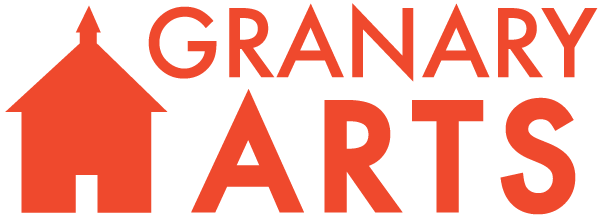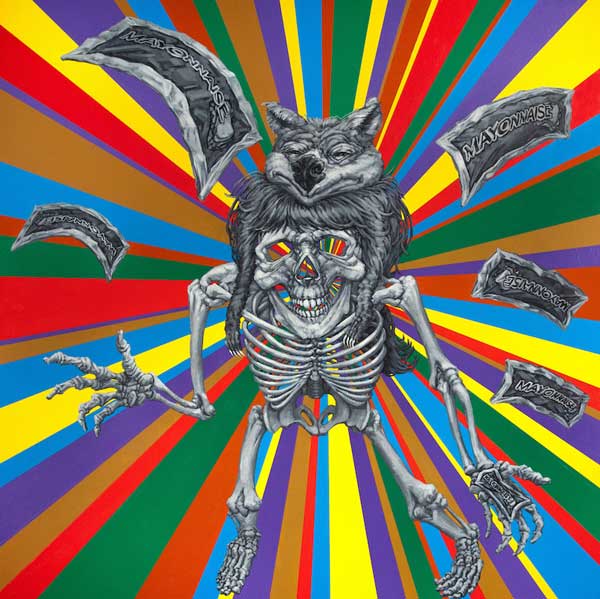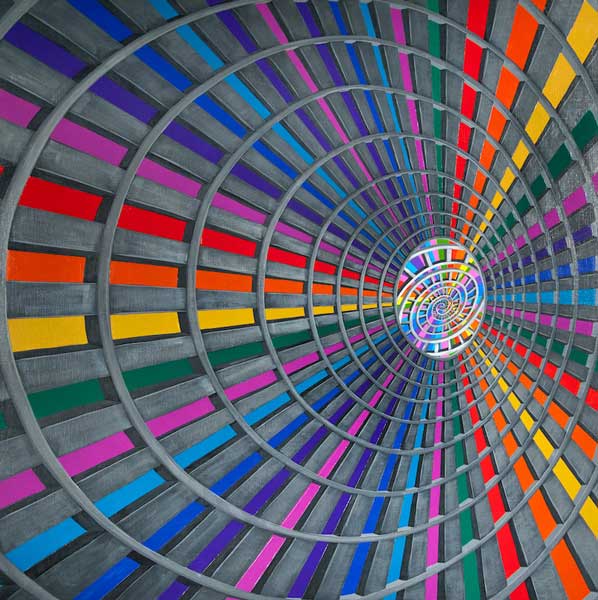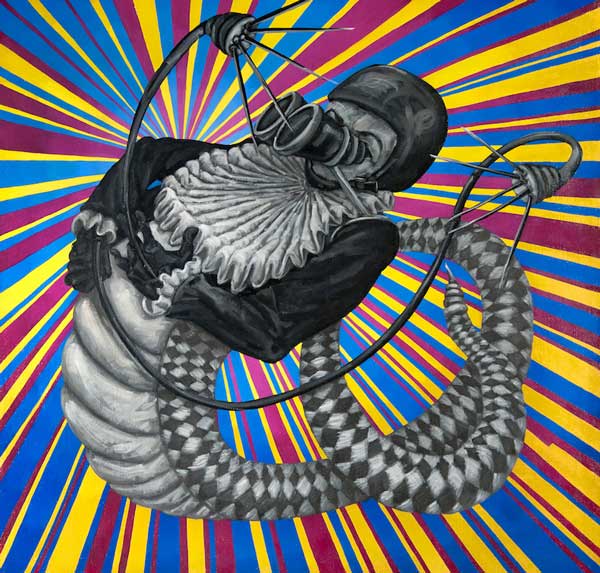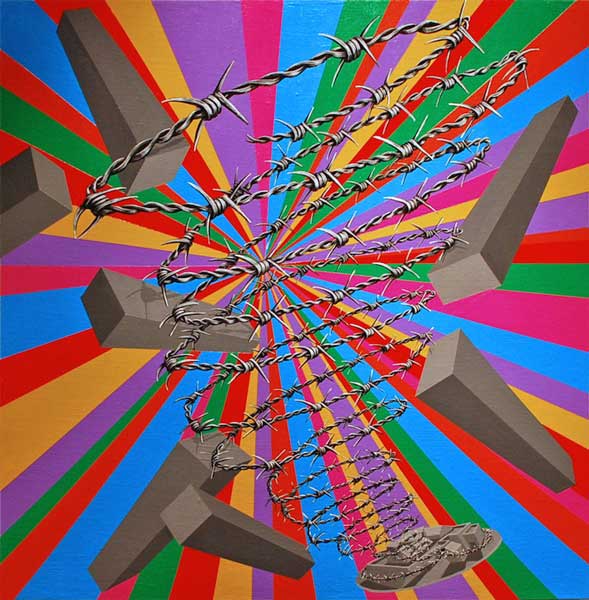V. KIM MARTINEZ / 7 Steps Forward 7 Steps Back
February 10 – May 13, 2016
7 Steps Forward 7 Steps Back a ritual that some indigenous peoples practice when a person dies. For seven days, four times a day the survivors pay homage to the deceased by visiting and marking their burial site with seven lines, they than walk forward seven steps to the site and when leaving walk backward seven steps. A practice to assure that the dead will have safe entry into the after life.
Header image: Bio Power, V. Kim Martinez
This exhibition is a result of on my experiences traveling routes used by Mexican/Native American migrants for thousands of years along the now United States and Mexico borders. My research strategy included print and electronic text, mapping of historical/contemporary northern/southern migratory routes, observational fieldwork that integrated conversations with migrants who have made the journey and my familial history.
Collaborating with high school teacher Jodi Deroche, we identified and traveled well-known routes used by migrants for thousands of years. Traveling within the margins of this rigid yet fluid space, allowed me the capacity to perceive others in a myriad ways, all of which are now dependant not on preconception but on circumstances and experiences.
We started our journey by volunteering with a non-profit organization Humane Borders, humanitarians to set-up water stations in desert locations to prevent migrant death. We traveled early in the day to avoid extreme heat, we cleaned sites, checked water tanks drained and filled as necessary. During this time, I witnessed armed forces carrying high-powered weapons on both sides of the border, predominantly on the U.S. side. We then progressed to the “Highway of the Devil,” however, we were prevented entrance by the Border Patrol after the murder of an agent the day before. We then preceded to Sasabe, Mexico, an economically downtrodden community whose residents’ major source of income is generated by making adobe-bricks, it is a U.S. border port of entry, one of the busiest migrant and drug smuggling corridors on the southern border. The mayor of Sasabe introduced us to an expatriate from California who became our guide to the area. We traveled to various shrines, staging areas for migrants, brick furnaces, artillery range, and witnessed more armed military. We ended our journey in the sister cities of Nogales famous for numerous underground tunnels and “The Line Fence” constructed from scrap U.S. military corrugated steel landing mats that separated our two countries. Before its’ replacement in 2011 to a single layered bollard-style fence, artists on both sides of the fence turned it into a space that depicted socially conscious art, including crosses to symbolize migrant deaths attempting to cross the Sonoran Desert. This section of the border is equipped with high-power surveillance equipment and roaming armed Agents who prevent any form of documentation.
The motivation to develop this series is multifaceted, but my foremost interest is to increase my understanding of the political and social discourse, with sensitivity to the southern border. The images are not literal but rather intellectual concepts and metaphors, for me, space is defined by human presence and motivation. The animated narrative strategy and the media process grew organically. The beginning, middle and end was fluid, I would draw a scene not really knowing what would come before or after. I allowed the process to determine the narrative outcome, resulting in an approach and intention that destabilizes the viewer by offering interpretive choices that may or may not seem plausible. Transportation becomes a metaphor for communication-the transfer of meaning from one place to another, isolating pieces of information repeating, changing scale, adding movement and reducing color is my attempt to reveal hidden structures of migration.
About the Artist
V. Kim Martinez, MFA, Professor of Painting and Drawing at the University of Utah, since 2001. Her research interests include: Painting and Drawing, Encaustic Painting, Community Murals, Foundry, Mosaics and Video Animation. She received her terminal degree from The School of the Art Institute of Chicago where she received the George L. & Ann Roman Siegel Foundation fellowship.
Professor Martinez’ research concerns visual communication that investigates societal structures that shift/fluctuate between the positive and the negative, the concrete and the abstract, based on direct experience with the challenges of specific locations and situations. Her research record includes over 150 curatorial regional, national and international exhibitions. Regional: Salt Lake City, Ogden, Park City, Ephraim, and Springville. National: New York, Illinois, California, New Mexico, Arizona, Colorado, Nebraska, Ohio and Vermont. International: Mexico, China, Colombia, Brazil, Guainía, Occupied Palestine Territory and Chile. Artist fellowships include: The Sara Lee Foundation, Ragsdale, Vermont Studio Center, Bemis Center for Contemporary Art, Social and Public Art Resource Center, International Iron Casters, Kenyon College, Grand Canyon University, the University of Utah John R. Parks/UCLA César Chávez Mural Lab and the College of Fine Arts.
Professor Martinez is an enthusiastic educator and is committed to public engagement through the arts. In 2002, she envisioned a community mural course to provide students real world experience to create, propose, and implement public art in the form of mural designs and site-specific painting throughout the Salt Lake City area. Martinez has received grants from The National Endowment for the Arts “Challenge America” through the Utah Arts Council, Utah Transit Authority, City of South Salt Lake, Salt Lake County, University of Utah Residential Living Center, Primary Children’s Medical Center, Department of Ballet, Our Lady of Lourdes Catholic School, Esperanza Elementary Charter School and the Utah Division of Services for the Blind and Visually Impaired. The grants have provided equipment and supplies to complete 24 murals as well as 159 student travel scholarships. Kim’s commitment to innovation and exploration of teaching methodologies is exemplified by a interdisciplinary undergraduate experience with biology and art students. Students in this intensive residency course at the University of Utah’s Rio Mesa Center simultaneously engaged in two disciplines: Landscape Painting and Landscape Ecology in an effort to implement intersection between the disciplines. Martinez is the recipient of the College of Fine Arts Faculty Excellence Award, the University of Utah’s Tanner Humanities Center “Professors Off-Campus Project,” the “Distinguished Innovation and Impact Award” and has received recognition from The Center for Disabilities.
Martinez’s commitment to university shared governance philosophy is reflected by her membership in the University Academic Senate and Executive Committee, Teaching Committee, Dee Council and Faculty Technology Committee. She served as chair for the Department of Art and Art History Warnock Committee, a biannual semester long campus residency designed to allow students to interact with nationally and internationally ranked visiting artists. She is currently serving as the Department of Art and Art History director of Graduate Studies, Studio. Professor Martinez has served on community board of directors and councils, South Salt Lake Arts Council, Art Access, Utah Hispanic Women’s Institute, Utah Cultural Celebrations Center Foundation, Utah Arts Festival and gubernatorial appointments to the Department of Corrections Advisory Council, and the Utah Correctional Industries Advisory Council. V. Kim Martinez is the recipient of the 2003 Salt Lake City Mayors Visual Artist Award, recognizing her community involvement and contribution to the Utah Department of Corrections Women’s facility, Veterans Administration, First Step House and Art Positive!
